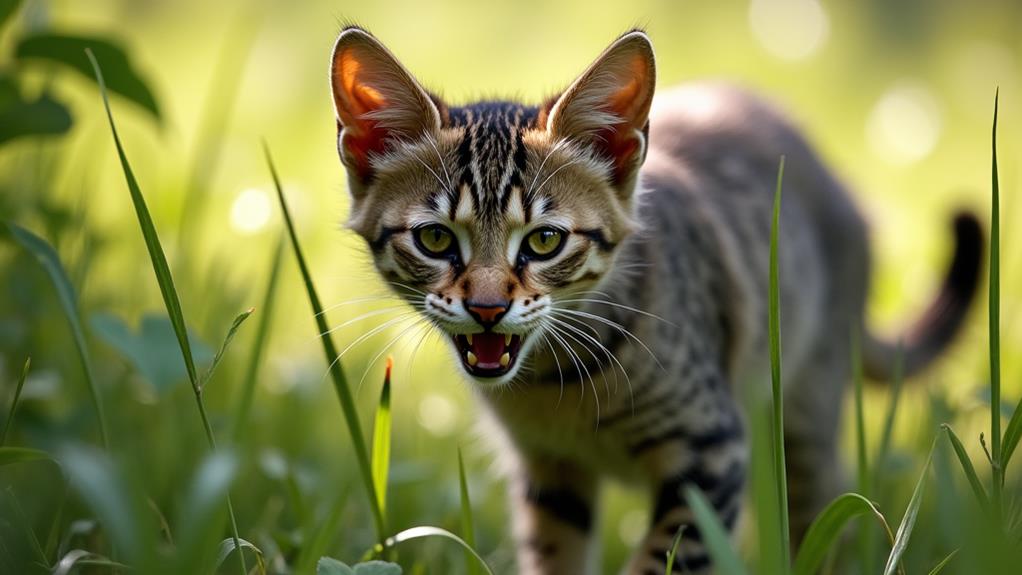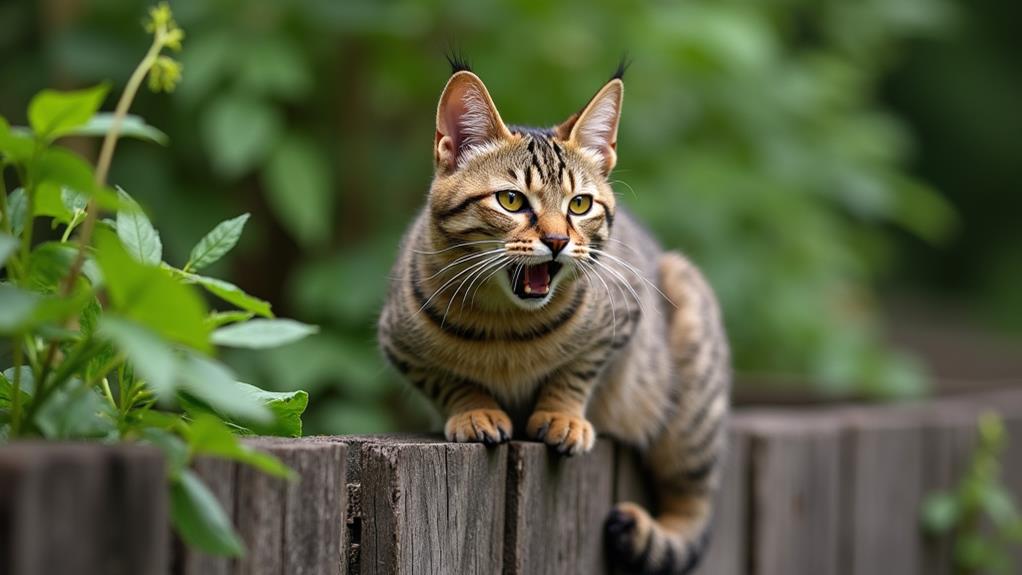What Does It Mean When a Feral Cat Meows at You? Understanding Feral Behavior

When a feral cat meows at you, it's intriguing because meowing is rare for them and usually meant for humans. This behavior means the cat might be seeking attention, food, or companionship, a learned behavior from past positive human interactions. The pitch and length of the meow can provide insight into its emotional state, with high-pitched meows indicating excitement and lower tones suggesting discomfort. Observing the cat's body language can offer further context. Building trust with feral cats requires patience, but understanding these vocal signals is a key initial step. There's much more to investigate in feral cat communication.
Feral Cat Communication
Feral cat communication is a fascinating combination of body language and limited vocalizations. When observing feral cats, you'll notice they rely heavily on non-verbal cues to convey their emotions and intentions. The way they hold their bodies, the movement of their tails, and the position of their ears are all integral parts of their communication. For these cats, instincts guide their behavior, helping them to survive in the wild. Vocalizations are less common, with growling and hissing often used as warnings or expressions of fear.
Though meowing is rare among feral cats, if you hear one meow, it might be because they've developed some comfort with humans. A meow directed at you can be a request for attention or food. This behavior reflects a level of trust and possibly learned communication from interactions with people. Feral cats also establish territory and social status through scent marking, making it a more prevalent form of communication than vocalizations.
Understanding these nuances in feral cat communication can greatly aid in interpreting their needs and behaviors. By paying attention to their body language and the few sounds they make, you can respond appropriately to their unique ways of interacting.
Reasons for Meowing
In the world of feral cats, meowing is an unusual behavior often directed towards humans rather than other cats. This intriguing form of communication might surprise you, as feral cats don't typically meow to each other. When a feral cat chooses to meow at you, it's often because they're seeking attention or interaction, possibly hinting at a need for food, companionship, or even signaling distress.
If a feral cat has experienced positive interactions with humans before, it might have learned that meowing is an effective way to communicate its needs. This behavior isn't innate among adult feral cats in the wild. Instead, it's a learned response, indicating that the cat may be reaching out because it feels some level of insecurity or requires assistance in an unfamiliar environment.
The frequency and tone of the meow can offer extra clues. A high-pitched meow might suggest excitement or urgency, while a lower-pitched sound could indicate discomfort or annoyance. Understanding these nuances can help you better interpret what the feral cat is trying to convey. By recognizing these signals, you can respond more effectively to the needs of feral cats in your community.
Interpreting Vocal Signals

Understanding the vocal signals of feral cats can greatly improve your interactions with them. Unlike domestic cats, feral cats don't typically meow at each other. Instead, they use meowing primarily as a communication method directed toward humans, often a learned behavior from past encounters. When a feral cat meows at you, it might be expressing a need for attention or food, or signaling discomfort. This indicates a potential bond or familiarity with humans.
Short, sharp meows usually suggest curiosity or a polite request for interaction, while longer meows might express urgency or a demand for immediate attention. It's important to observe the context of the meow, including the cat's body language and environment, to better understand its emotional state and intentions. For instance, a relaxed body might indicate a friendly approach, whereas a tense posture could signal distress or caution.
Continuous or excessive meowing from a feral cat may suggest distress, loneliness, or health issues. Paying careful attention to these vocal signals allows you to address the cat's needs more effectively. By understanding these cues, you can respond appropriately, ensuring a positive interaction with feral cats.
Building Trust With Ferals
Establishing trust with feral cats isn't a quick process; it demands patience and consistent effort over time. Feral cats can take months or even years to feel comfortable around humans. To start building trust, confirm you maintain regular feeding schedules, which helps them associate people with positive experiences. Predictability in feeding can make them more open to the idea of human interaction.
Creating a safe environment is vital. Provide hiding spots and shelters to help feral cats feel secure. When they know they have a place to retreat, they're more likely to approach you willingly. Your body language plays a significant role too—keep it calm and avoid sudden movements to prevent scaring them away. This approach aids in gradual trust-building.
Consistent interactions are key. Engage with them regularly, but allow them to set the pace. Use positive reinforcement like gentle vocalizations and treats to encourage them to come closer. This method not only fosters a bond of trust but also shows them that you're not a threat. Over time, these small, positive interactions can lead to a meaningful connection with feral cats.
Health and Welfare Concerns

When addressing the health and welfare concerns of feral cats, it is imperative to pay close attention to their behavior, especially vocalizations like meowing. Feral cats generally avoid meowing to steer clear of predators, so when they do, it might signal distress or a need for help. This behavior could indicate underlying health issues such as pain, injury, or illness, which require a prompt veterinary evaluation. By identifying these issues, you can guarantee their well-being and safety.
Moreover, meowing can also be a sign of a feral cat being in heat or seeking mates, contributing to overpopulation if not addressed. To prevent this, implementing Trap-Neuter-Return (TNR) programs is fundamental. These programs help control the population by having cats spayed or neutered, thereby reducing health concerns associated with overpopulation and mating behaviors.
Additionally, a feral cat's meow might be a plea for food and safety. Monitoring their population and guaranteeing food safety is critical to improve their health and welfare. By understanding the context of a feral cat's meowing, you can implement appropriate interventions and provide much-needed care.
Community Support Resources
With growing awareness of feral cat populations, community support resources have become invaluable in managing their welfare. Local animal shelters and rescue organizations are vital allies, often providing information on Trap-Neuter-Return (TNR) programs. These programs are fundamental for controlling feral cat numbers and advancing their general well-being. By participating in TNR, you contribute to a healthier environment for these cats and help stabilize the community's feline population.
Workshops and training sessions are available in many areas, offering you a chance to learn how to safely care for or socialize with feral cats. Understanding feline behavior is key to interacting with them effectively. These educational opportunities improve your ability to provide responsible feeding and care, ensuring that feral cats receive the support they need.
Online platforms and social media groups also play a significant role in community support. By engaging with others, you can share experiences, tips, and advice about feral cat care. Local veterinary clinics often offer discounted services or partner with rescue organizations to provide the necessary medical care, such as vaccinations and spaying/neutering. Educational materials, including brochures and websites, further support your efforts by highlighting the importance of responsible feeding and TNR benefits.




